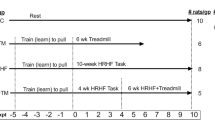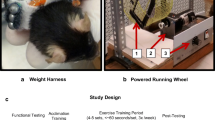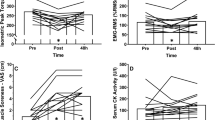Abstract
In this study, we examined the effects of 2-week hindlimb un-loading in mice followed by re-ambulation with voluntary access to running wheels. The recovery period was terminated at a time point when physical performance—defined by velocity, time, and distance ran per day—of the suspended group matched that of an unsuspended group. Mice were assigned to one of four groups: unsuspended non-exercise (Control), 14 days of hindlimb suspension (HS), 7 days of access to running wheels (E7), or 14 days of HS plus 7 days access to running wheels (HSE7). HS resulted in significant decreases in body and muscle mass, hindlimb strength, soleus force, soleus specific force, fatigue resistance, and fiber cross sectional area (CSA). Seven days of re-ambulation with access to running wheels following HS recovered masses to Control values, increased fiber CSA, increased resistance to fatigue and improved recovery from fatigue in the soleus. HS resulted in a myosin heavy chain (MHC) phenotype shift from slow toward fast-twitch fibers, though running alone did not influence the expression of MHC fibers. Compared to the Control group, HSE7 mice did not recover functional hindlimb strength as assessed through measurements either in vivo or ex vivo. Results from this study demonstrate that 7 days of muscle re-loading with access to wheel-running following HS can stimulate muscle to regain mass and fiber CSA and exhibit improved metrics of fatigue resistance and recovery, yet muscles remain impaired in regard to strength. Understanding this mismatch between muscle morphology and strength may prove of value in designing effective exercise protocols for disuse muscle atrophy rehabilitation.








Similar content being viewed by others
References
Akima H, Kawakami Y, Kubo K, Sekiguchi C, Ohshima H, Miyamoto A, Fukunaga T (2003) Effect of short-duration spaceflight on thigh and leg muscle volume. Med Sci Sports Exerc 32:1743–1747
Allen DL, Harrison BC, Maass A, Bell ML, Byrnes WC, Leinwand LA (2001) Cardiac and skeletal muscle adaptations to voluntary wheel running in the mouse. J Appl Physiol 90:1900–1908
Allen MR, Hogan HA, Bloomfield SA (2006) Differential bone and muscle recovery following hindlimb unloading in skeletally mature male rats. J Musculoskelet Neuronal Interact 6:217–225
Baldwin KM, Haddad F (2001) Effects of different activity and inactivity paradigms on myosin heavy chain gene expression in striated muscle. J Appl Physiol 90:345–357
Bodine SC et al (2001) Identification of ubiquitin ligases required for skeletal muscle atrophy. Science 294:1704–1708
Caiozzo VJ, Haddad F, Baker MJ, Herrick RE, Prietto N, Baldwin KM (1996) Microgravity-induced transformations of myosin isoforms and contractile properties of skeletal muscle. J Appl Physiol 81:123–132
Cannon CMA, Dieter-Seelig H, Stodieck LS, Hanson AM, Simske SJ, Ferguson VL (2005) A novel combination of methods to assess sarcopenia and muscle performance in mice. Biomed Sci Instrum 41:116–121
Carlson CG, Makiejus RV (1990) A noninvasive procedure to detect muscle weakness in the mdx mouse. Muscle Nerve 13:480–484
Carlson CJ, Booth FW, Gordon SE (1999) Skeletal muscle myostatin mRNA expression is fiber-type specific and increases during hindlimb unloading. Am J Physiol 277:R601–R606
D’Aunno DS, Robinson RR, Smith GS, Thomason DB, Booth FW (1992) Intermittent acceleration as a countermeasure to soleus muscle atrophy. J Appl Physiol 72:428–433
Dapp C, Schmutz S, Hoppeler H, Fluck M (2004) Transcriptional reprogramming and ultrastructure during atrophy and recovery of mouse soleus muscle. Physiol Genomics 20:97–107
Dumont N, Frenette J (2010) Macrophages protect against muscle atrophy and promote muscle recovery in vivo and in vitro: a mechanism partly dependent on the insulin-like growth factor-1 signaling molecule. Am J Pathol 176:2228–2235
Dumont N, Bouchard P, Frenette J (2008) Neutrophil-induced skeletal muscle damage: a calculated and controlled response following hindlimb unloading and reloading. Am J Physiol Regul Integr Comp Physiol 295:R1831–R1838
Fitts RH, Romatowski JG, De La Cruz L, Widrick JJ, Desplanches D (2000) Effect of spaceflight on the maximal shortening velocity, morphology, and enzyme profile of fast- and slow-twitch skeletal muscle fibers in rhesus monkeys. J Gravit Physiol 7:S37–S38
Fitzsimons DP, Diffee GM, Herrick RE, Baldwin KM (1990) Effects of endurance exercise on isomyosin patterns in fast- and slow-twitch skeletal muscles. J Appl Physiol 68:1950–1955
Grosset JF, Onambele-Pearson G (2008) Effect of foot and ankle immobilization on leg and thigh muscles’ volume and morphology: a case study using magnetic resonance imaging. Anat Rec (Hoboken) 291:1673–1683
Haida N, Fowler WM, Abresch RT, Larson DB, Sharman RB, Taylor RG, Entrikin RK (1989) Effect of hind-limb suspension on young and adult skeletal muscle. I. Normal mice. Exp Neurol 103:68–76
Hanson AM, Ferguson VL, Simske SJ, Cannon CMA, Stodieck LS (2005) Comparison of tail-suspension and sciatic nerve crush on the musculoskeletal system in young-adult mice. Biomed Sci Instrum 41:92–96
Harridge SD, Bottinelli R, Canepari M, Pellegrino M, Reggiani C, Esbjörnsson M, Balsom PD, Saltin B (1998) Sprint training, in vitro and in vivo muscle function, and myosin heavy chain expression. J Appl Physiol 84:442–449
Harrison BC, Bell ML, Allen DL, Byrnes WC, Leinwand LA (2002) Skeletal muscle adaptations in response to voluntary wheel running in myosin heavy chain null mice. J Appl Physiol 92:313–322
Harrison BC, Allen DL, Girten B, Stodieck LS, Kostenuik PJ, Bateman TA, Morony S, Lacey D, Leinwand LA (2003) Skeletal muscle adaptations to microgravity exposure in the mouse. J Appl Physiol 95:2462–2470
Hayes A, Williams DA (1996) Beneficial effects of voluntary wheel running on the properties of dystrophic mouse muscle. J Appl Physiol 80:670–679
Holloszy JO, Coyle EF (1984) Adaptations of skeletal muscle to endurance exercise and their metabolic consequences. J Appl Physiol 56:831–838
Ishihara A, Inoue N, Katsuta S (1991) The relationship of voluntary running to fibre type composition, fibre area and capillary supply in rat soleus and plantaris muscles. Eur J Appl Physiol Occup Physiol 62:211–215
Ishihara A, Kawano F, Ishioka N, Oishi H, Higashibata A, Shimazu T, Ohira Y (2004) Effects of running exercise during recovery from hindlimb unloading on soleus muscle fibers and their spinal motoneurons in rats. Neurosci Res 48:119–127
Kasper CE, White TP, Maxwell LC (1990) Running during recovery from hindlimb suspension induces transient muscle injury. J Appl Physiol 68:533–539
LeBlanc A, Rowe R, Schneider V, Evans H, Hedrick T (1995) Regional muscle loss after short duration spaceflight. Aviat Space Environ Med 66:1151–1154
LeBlanc A et al (2000) Muscle volume, MRI relaxation times (T2), and body composition after spaceflight. J Appl Physiol 89:2158–2164
Li P, Akimoto T, Zhang M, Williams RS, Yan Z (2006) Resident stem cells are not required for exercise-induced fiber-type switching and angiogenesis but are necessary for activity-dependent muscle growth. Am J Physiol Cell Physiol 290:C1461–C1468
Litvinova K, Tarakin P, Fokina N, Istomina V, Larina I, Shenkman B (2007) Reloading of rat soleus after hindlimb unloading and serum insulin-like growth factor 1. Ross Fiziol Zh Im I M Sechenova 93:1143–1155
McCarthy JJ, Fox AM, Tsika GL, Gao L, Tsika RW (1997) Beta-MHC transgene expression in suspended and mechanically overloaded/suspended soleus muscle of transgenic mice. Am J Physiol 272:R1552–R1561
McNulty AL, Otto AJ, Kasper CE, Thomas DP (1992) Effect of recovery mode following hind-limb suspension on soleus muscle composition in the rat. Int J Sports Med 13:6–14
Morey E, Sabelman E, Turner R, Baylink D (1979) A new rat model simulating some aspects of space flight. Physiologist 22:S23–S24
Narici M, Kayser B, Barattini P, Cerretelli P (2003) Effects of 17-day spaceflight on electrically evoked torque and cross-sectional area of the human triceps surae. Eur J Appl Physiol 90:275–282
Ohlendieck K, Frömming GR, Murray BE, Maguire PB, Leisner E, Traub I, Pette D (1999) Effects of chronic low-frequency stimulation on Ca2+-regulatory membrane proteins in rabbit fast muscle. Pflugers Arch 438:700–708
Ortenblad N, Lunde PK, Levin K, Andersen JL, Pedersen PK (2000) Enhanced sarcoplasmic reticulum Ca(2+) release following intermittent sprint training. Am J Physiol Regul Integr Comp Physiol 279:R152–R160
Paoni NF et al (2002) Time course of skeletal muscle repair and gene expression following acute hind limb ischemia in mice. Physiol Genomics 11:263–272
Pellegrino MA, Brocca L, Dioguardi FS, Bottinelli R, D’Antona G (2005) Effects of voluntary wheel running and amino acid supplementation on skeletal muscle of mice. Eur J Appl Physiol 93:655–664
Pette D, Staron RS (2001) Transitions of muscle fiber phenotypic profiles. Histochem Cell Biol 115:359–372
Pottle D, Gosselin LE (2000) Impact of mechanical load on functional recovery after muscle reloading. Med Sci Sports Exerc 32:2012–2017
Prisby R, Nelson A, Latsch E (2004) Eccentric exercise prior to hindlimb unloading attenuated reloading muscle damage in rats. Aviat Space Environ Med 75:941–946
Rittweger J, Frost HM, Schiessl H, Ohshima H, Alkner B, Tesch P, Felsenberg D (2005) Muscle atrophy and bone loss after 90 days’ bed rest and the effects of flywheel resistive exercise and pamidronate: results from the LTBR study. Bone 36:1019–1029
Salazar J, Michele D, Brooks S (2010) Inhibition of calpain prevents muscle weakness and disruption of sarcomere structure during hinglimb suspension. J Appl Physiol 108:120–127
Simske SJ, Greenberg AR, Luttges MW (1991) Effects of suspension-induced osteopenia on the mechanical behaviour of mouse long bones. J Mater Sci Mater Med 2:43–50
Simske S, Schmeister T, Fleet M, Broz J, Gayles E, Luttges M (1994) An experimental model for combined neural, muscular, and skeletal degeneration. J Neuromusculoskelet Syst 2:116–123
Sugiura T, Morimoto A, Sakata Y, Watanabe T, Murakami N (1990) Myosin heavy chain isoform changes in rat diaphragm are induced by endurance training. Jpn J Physiol 40:759–763
Sugiura T, Morimoto A, Murakami N (1992) Effects of endurance training on myosin heavy-chain isoforms and enzyme activity in the rat diaphragm. Pflugers Arch 421:77–81
Sugiura T, Abe N, Nagano M, Goto K, Sakuma K, Naito H, Yoshioka T, Powers SK (2005) Changes in PKB/Akt and calcineurin signaling during recovery in atrophied soleus muscle induced by unloading. Am J Physiol Regul Integr Comp Physiol 288:R1273–R1278
Thomason DB, Booth FW (1990) Atrophy of the soleus muscle by hindlimb unweighting. J Appl Physiol 68:1–12
Thomason DB, Herrick RE, Surdyka D, Baldwin KM (1987) Time course of soleus muscle myosin expression during hindlimb suspension and recovery. J Appl Physiol 63:130–137
Tidball JG, Berchenko E, Frenette J (1999) Macrophage invasion does not contribute to muscle membrane injury during inflammation. J Leukoc Biol 65:492–498
van der Velden JLJ, Langen RCJ, Kelders MCJM, Willems J, Wouters EFM, Janssen-Heininger YMW, Schols AMWJ (2007) Myogenic differentiation during regrowth of atrophied skeletal muscle is associated with inactivation of GSK-3beta. Am J Physiol Cell Physiol 292:C1636–C1644
Vermaelen M, Marini JF, Chopard A, Benyamin Y, Mercier J, Astier C (2005) Ubiquitin targeting of rat muscle proteins during short periods of unloading. Acta Physiol Scand 185:33–40
Warren GL, Stallone JL, Allen MR, Bloomfield SA (2004) Functional recovery of the plantarflexor muscle group after hindlimb unloading in the rat. Eur J Appl Physiol 93:130–138
Waters RE, Rotevatn S, Li P, Annex BH, Yan Z (2004) Voluntary running induces fiber type-specific angiogenesis in mouse skeletal muscle. Am J Physiol Cell Physiol 287:C1342–C1348
Widrick JJ, Maddalozzo GF, Hu H, Herron JC, Iwaniec UT, Turner RT (2008) Detrimental effects of reloading recovery on force, shortening velocity, and power of soleus muscles from hindlimb-unloaded rats. Am J Physiol Regul Integr Comp Physiol 295:R1585–R1592
Witzmann FA, Kim DH, Fitts RH (1982) Recovery time course in contractile function of fast and slow skeletal muscle after hindlimb immobilization. J Appl Physiol 52:677–682
Zange J et al (1997) Changes in calf muscle performance, energy metabolism, and muscle volume caused by long-term stay on space station MIR. Int J Sports Med 18(Suppl 4):S308–S309
Acknowledgments
The authors would like to acknowledge Hans Deiter-Seelig for designing the Labview™ programs necessary for HEFT and electrophysiology data collection. We would also like to express our sincere thanks to the Leinwand Lab in the Department of Molecular, Cellular, and Developmental Biology at the University of Colorado for providing the antibodies used to stain for MHC-IIa, MHC-IIX, and MHC-IIb expressing fibers. Finally, we acknowledge and thank Brooke Harrison for his guidance and technical support of the immunohistochemical methods and analysis. Fundings by BioServe Space Technologies and NASA Cooperative Agreement NCC8-242.
Author information
Authors and Affiliations
Corresponding author
Rights and permissions
About this article
Cite this article
Hanson, A.M., Stodieck, L.S., Cannon, C.M.A. et al. Seven days of muscle re-loading and voluntary wheel running following hindlimb suspension in mice restores running performance, muscle morphology and metrics of fatigue but not muscle strength. J Muscle Res Cell Motil 31, 141–153 (2010). https://doi.org/10.1007/s10974-010-9218-5
Received:
Accepted:
Published:
Issue Date:
DOI: https://doi.org/10.1007/s10974-010-9218-5




